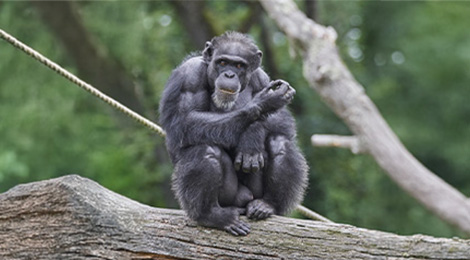The world’s largest hornbill
Southern ground hornbills have entirely black plumage. The areas around their eyes and on their neck are featherless and reveal the bird’s red skin. Their beak bears a protuberance known as a casque, which is more pronounced in the male.
The Southern ground hornbill is a vulnerable species that has suffered from habitat destruction, hunting and illegal trade for African medicine. With a slow reproduction rate, it is a species under threat.
Southern ground hornbills can be found in the open savannas of sub-Saharan Africa, in wet grassland and in the wooded areas of Kenya, Botswana, Zambia and Tanzania.
Only two species are considered ground hornbills as they spend most of their time on terra firma. They prefer to hunt on foot and can cover several kilometres while looking for food.
Ground hornbills are relatively sociable animals. They live in small family groups comprising 2 to 8 individuals. They use song to mark out their territory, which can extend up to 100 km².
The Southern ground hornbill is the only one that does not seal the female within a tree cavity used as a nest. Clans are highly structured with one dominant mating couple, while the rest of the group (usually males) look for food and, if necessary, protect the nest. Their young remain in the nest for around three months, the time needed for their development and to learn how to fly. They definitively leave the nest and become independent at around the age of one.
Hornbills are sedentary, and the only migration that takes place is when their young reach maturity. It is usually the females who migrate to go on to form their own group.
-
HabitatGrassland, savannas
-
Food
Insects, small reptiles, amphibians, small mammals, fruit

The Latin name for the species, Bucorvus leadbeateri, commemorates the British taxidermist and merchant of natural history materials, Benjamin Leadbeater (1760-1837).
A zoological reserve populated by Asian elephants, giraffes, lions, tigers, hippos, chimpanzees, gibbons, wolves, ostriches ... Animals evolving in their reconstituted natural environment, to discover as a family.
All animals
-
![]() Chimpanzee Discover animal
Chimpanzee Discover animal -
![]() Crowned crane Discover animal
Crowned crane Discover animal -
![]() Golden-bellied capuchin Discover animal
Golden-bellied capuchin Discover animal -
![Un éléphant se baladant au parc animalier Le PAL]() Asian elephant Discover animal
Asian elephant Discover animal -
![]() Lar gibbon Discover animal
Lar gibbon Discover animal -
![]() White stork Discover animal
White stork Discover animal -
![]() Eurasian eagle owl Discover animal
Eurasian eagle owl Discover animal -
![Gros plan sur une Conure soleil et son plumage coloré au parc animalier Le PAL]() Sun parakeet Discover animal
Sun parakeet Discover animal -
![Flamant du Chili debout dans l'eau au parc animalier Le PAL]() Chilean flamingo Discover animal
Chilean flamingo Discover animal













